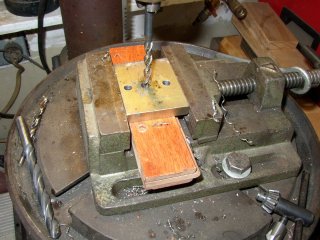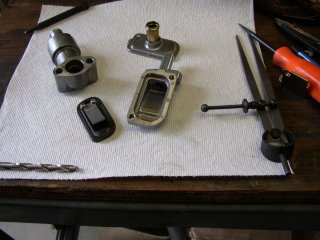You are using an out of date browser. It may not display this or other websites correctly.
You should upgrade or use an alternative browser.
You should upgrade or use an alternative browser.
PCV Valve
- Thread starter olympus
- Start date
- Status
- Not open for further replies.
concours
VIP MEMBER
- Joined
- Dec 29, 2011
- Messages
- 8,672
I mounted my XS650 breather there...Looking at the PCV reed breather supplied by Holland Norton Works. it appears to be mounted to the top frame tube behind the air filter ... To get the best operation from this valve shouldn't it be mounted as close the crankcase as possible...
My reasoning was/is, condensate can drain back on both sides. The reason I think that is important is, otherwise, you’ll have a column of viscous oil/moisture splooge accumulated in the hose rising up to the oil tank. That column will not purge itself until the crankcase pressure overcomes it’s inertia, and with sufficient volume to carry the splooge through (versus blow bubbles THROUGH it, which is the likely result).
It’s been working great for 32,000 miles.
Last edited:
- Joined
- Jul 20, 2017
- Messages
- 387
The HNW valve I fitted to my MK2A last year ended up about midway between engine and oil tank – the plastic airbox is in the way of the top location, although Constant of HNW told me I could heat and deform the plastic to make it fit. I didn't fancy that, so I made up a little bracket and hung the valve vertically off the drive side of the airbox, between it and the battery. But maybe the stuff about the plastic airbox is irrelevant to you – the main thing is, the HNW valve (I imagine it's sourced from a manufacturer …?) presently on offer looks as though condensate would drain back through it, so long as it's the right way up. It can be vertical or horizontal, as long as the exit to the oil tank is at the top. I note with some curiosity that it's shown mounted horizontally (scroll or search the linked page for 'PCV engine breather valve #H14') with both spigots at the same level – I don't see how condensate can drain like that so I wouldn't do it, but Constant's the expert here compared to me, and might chime in …? Maybe it just pools there when the engine's shut off, and it doesn't matter.
My valve looks similar but is arranged differently, with both spigots at the same 'end' – it has a small drain allowing condensate to clear back down to the engine, and that can only work if the valve is the right way up. I can imagine that the current offering is a better idea. But I can assure you that gunge does make it all the way to the tank, through my valve. HTH.
My valve looks similar but is arranged differently, with both spigots at the same 'end' – it has a small drain allowing condensate to clear back down to the engine, and that can only work if the valve is the right way up. I can imagine that the current offering is a better idea. But I can assure you that gunge does make it all the way to the tank, through my valve. HTH.
Last edited:
xbacksideslider
VIP MEMBER
- Joined
- Aug 19, 2010
- Messages
- 1,962
I agree the best vacuum signal is at the source. So on my '73 750, an XS650 reed valve is mounted directly to the crankcases where the original breather elbow was. I had to trim the waist of the reed valve body on both sides and fabricate a clamping plate, to hold it tight to the cases, but I was able to use the narrower pattern of the breather's bolt holes. Not pretty but effective.
Looking into the oil tank at the breather return, that reed valve starts returning wet sumped oil with a few key off kicks. Between the reed valve and the scavange side, I don't get all of the sump's oil, but it helps.
Looking into the oil tank at the breather return, that reed valve starts returning wet sumped oil with a few key off kicks. Between the reed valve and the scavange side, I don't get all of the sump's oil, but it helps.
- Joined
- Aug 5, 2017
- Messages
- 1,400
The reason for asking was off the potential risk of emulsified oil building up in the hose & blocking it ... any run of hose even short can cause sludge to form with ease so mounting it as close to the hot engine is surely better especially in our cooler countries. as you say perfectly fine in hotter climates.
I remember back to the mid 70's removing rocker covers of early GM product to find then thickly plasters in white sludge & every hose blocked solid.
I remember back to the mid 70's removing rocker covers of early GM product to find then thickly plasters in white sludge & every hose blocked solid.
- Joined
- Aug 5, 2017
- Messages
- 1,400
I take it you have the crankcase mounted breather? ... so did you use a short section of hose between PCV & OE breather body.I agree the best vacuum signal is at the source. So on my '73 750, an XS650 reed valve is mounted directly to the crankcases where the original breather elbow was. I had to trim the waist of the reed valve body on both sides and fabricate a clamping plate, to hold it tight to the cases, but I was able to use the narrower pattern of the breather's bolt holes. Not pretty but effective.
Looking into the oil tank at the breather return, that reed valve starts returning wet sumped oil with a few key off kicks. Between the reed valve and the scavange side, I don't get all of the sump's oil, but it helps.
Do you have a picture ??
- Joined
- Aug 17, 2011
- Messages
- 34
I note with some curiosity that it's shown mounted horizontally (scroll or search the linked page for 'PCV engine breather valve #H14') with both spigots at the same level – I don't see how condensate can drain like that so I wouldn't do it, but Constant's the expert here and might chime in …? Maybe it just pools there when the engine's shut off, and it doesn't matter.
Hi,
The PCV engine breather valve [HASHTAG]#H14[/HASHTAG] can be fitted anywhere in between the engine breather hose. Theoretically best way to fit it is as close as possible to the crankcases however in practice the difference isn't noticeable, fitted anywhere it does benefit to reduce excessive engine pressure and will eliminate oil leaks at all gasket joints associated with that excessive engine pressure. Also the valve can be fitted in every position, any condensate or remaining oil will be blown out the breather system as soon as you fired up your engine. However if you want to be dead sure no blocking will occur you can drill a 1,5mm safety hole next to the reed valve inside the breather valve.
Constant
www.hollandnortonworks.eu
Last edited:
xbacksideslider
VIP MEMBER
- Joined
- Aug 19, 2010
- Messages
- 1,962
Somehow I do not have a pic of the finished piece but here are two pics that illustrate what I did.
The aluminum plate goes between the case and the breather, eliminating the breather's 90* hose barb and allowing the crankcase to breath through the plate's center hole and into the reed valve body. The sides of the breather were trimmed to make room for the bolts that hold the whole thing to the cases. IIRC there was also a second thinner plate that sandwiched the breather and gave proper purchase to the underside of the fastening bolts. It's a tight fit with little clearance toward the gearbox. Been on there for maybe ten years. I should pull it off for an inspection of the reeds but then . . . . it still pumps oil on key off kick over.
The aluminum plate goes between the case and the breather, eliminating the breather's 90* hose barb and allowing the crankcase to breath through the plate's center hole and into the reed valve body. The sides of the breather were trimmed to make room for the bolts that hold the whole thing to the cases. IIRC there was also a second thinner plate that sandwiched the breather and gave proper purchase to the underside of the fastening bolts. It's a tight fit with little clearance toward the gearbox. Been on there for maybe ten years. I should pull it off for an inspection of the reeds but then . . . . it still pumps oil on key off kick over.
Attachments
- Status
- Not open for further replies.


